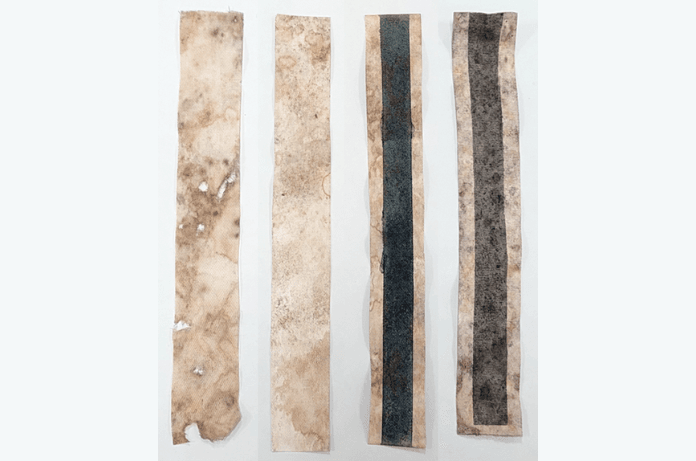Textile is often referred to as the second skin of the human body. Textile has a history of about 27000 years. In modern civilization, textiles play a pivotal role right making a fashion statement to leaving a luxury footprint. Now, assume textiles can monitor health and leave no trace behind when discarded. This is now a reality, not just a dream. Scientists in the UK have made it happen. A combined study by the University of Exeter, Cambridge, Leeds, and Bath discovered that wearable electronic textiles (e-textiles) called ‘Smart, Wearable, and Eco-friendly Electronic Textiles,’ or ‘SWEET,’ can be both highly functional and environmentally sustainable.
Published in the journal Energy and Environmental Materials, this innovation addresses one of the most pressing concerns in modern wearable technology: the challenge of balancing utility with ecological responsibility.
What Are E-Textiles, and Why Do They Matter?
E-textiles are fabrics with built-in electrical components like sensors, batteries, or lights. These components allow the fabrics to perform special tasks. People use e-textiles more and more in healthcare, sportswear, and fashion. They can track vital signs and improve athletic performance. Their uses keep growing.
Yet, the rise of e-textiles brings its own set of problems. Traditional designs often incorporate metals like silver, which are not biodegradable, making recycling and disposal a significant challenge. As a result, these advanced fabrics risk contributing to the ever-growing problem of clothing waste.
SWEET: A New Sustainable Era for E-Textiles
Led by Professor Nazmul Karim of the University of Southampton’s Winchester School of Art, the SWEET project has developed a sustainable solution to this challenge. Their design has a three-layer system: a sensing layer, a sensor interface layer, and a biodegradable base fabric.
At the heart of this innovation is Tencel, a fabric made from renewable wood. This Tencel serves as the base and it is biodegradable. So it naturally breaks down when thrown away. The electronic components are made from graphene and a polymer called PEDOT: PSS. These components are precision inkjet-printed onto the fabric. This process not only ensures minimal material waste but also reduces the use of water and energy compared to conventional screen printing methods.
Real-World Testing and Reliable Results
The SWEET team didn’t stop at theoretical innovation—they tested their material in real-world conditions. Five volunteers participated in a study to assess the fabric’s ability to monitor human physiology. Swatches of the SWEET material were attached to gloves worn by the participants, enabling continuous monitoring of their heart rate and body temperature.
The results were impressive. This material met industry standards for accuracy. Additionally, it demonstrated reliable performance, paving the way for its use in critical applications such as healthcare.
Designed to Decompose
A key breakthrough of the SWEET project lies in its biodegradability. To measure this, researchers buried samples of the e-textiles in soil. After just four months, the fabric had lost 48% of its weight and 98% of its strength, signaling rapid and effective decomposition.
This represents a stark contrast to traditional e-textiles, which often linger in landfills for decades due to their non-biodegradable components.

Beyond its biodegradable properties, SWEET e-textiles have an impressively low environmental effect. The team conducted a life cycle assessment. These assessments revealed that graphene-based electrodes used in SWEET have up to 40 times less environmental impact than traditional metal-based electrodes.
Healthcare Innovation Meets Sustainability
The SWEET project’s potential extends far beyond the lab. The researchers foresee garments made from SWEET being used in the healthcare industry for early detection and prevention of heart-related diseases. Considering that over 640 million people worldwide suffer from such conditions the impact could be monumental.
Professor Karim emphasizes the broader implications: “As pollution from landfill sites continues to rise, our study addresses the gap in research on the biodegradation of e-textiles. These materials are becoming increasingly important, especially in healthcare, making it essential to find ways to make them more eco-friendly in both manufacturing and disposal.”
The Future of Wearable Tech Is SWEET
The SWEET initiative is more than a scientific breakthrough. It’s a roadmap for a future where wearable technology and sustainability coexist harmoniously. By combining innovative materials like graphene with sustainable practices like inkjet printing, this project proves that high-tech garments don’t have to come at the cost of the environment.
As the fashion, healthcare, and technology industries strive to become more responsible, innovations like SWEET offer a glimmer of hope. They remind us that it’s possible to design products that benefit both people and the planet.
So, the next time you think about wearable technology, consider this: with the right materials and a commitment to sustainability, the clothes of the future won’t just be smart—they’ll be kind to the earth too.

